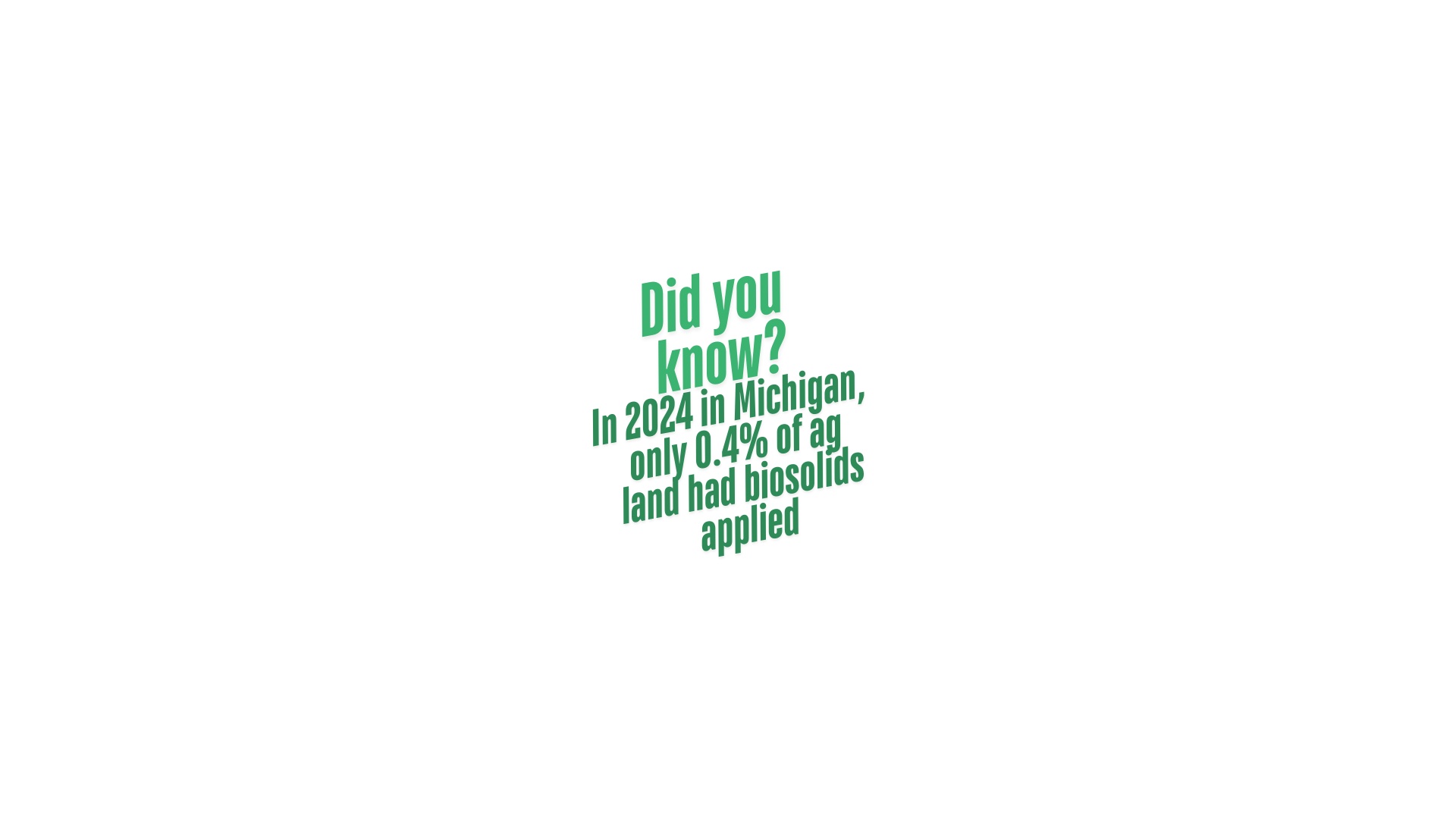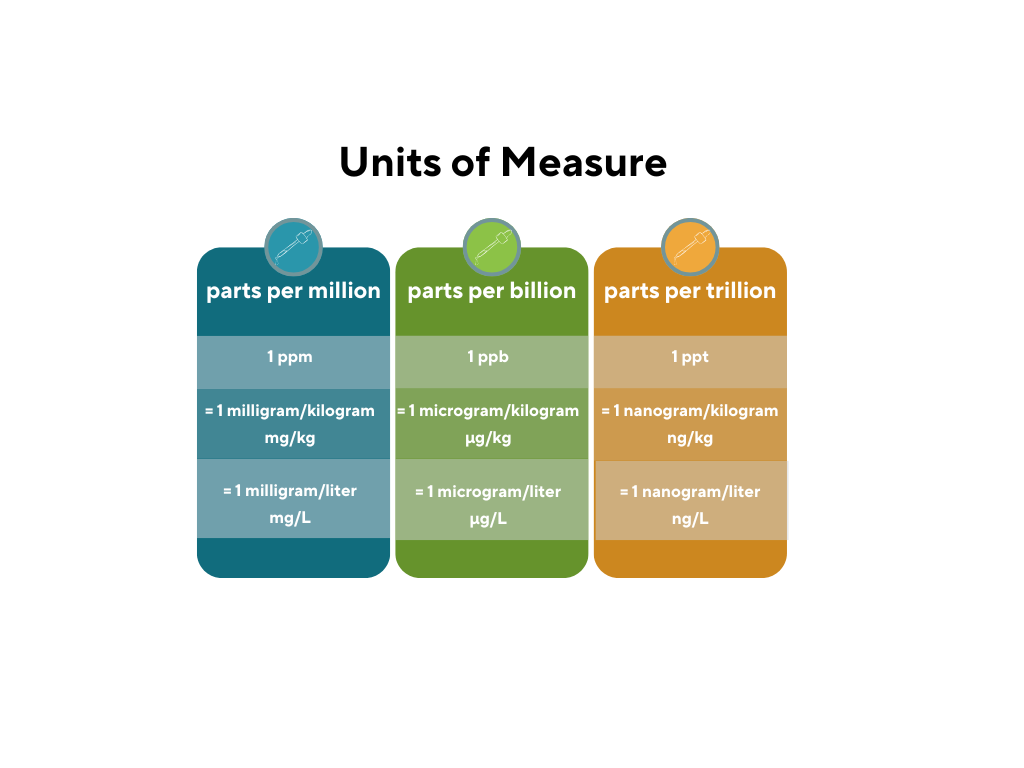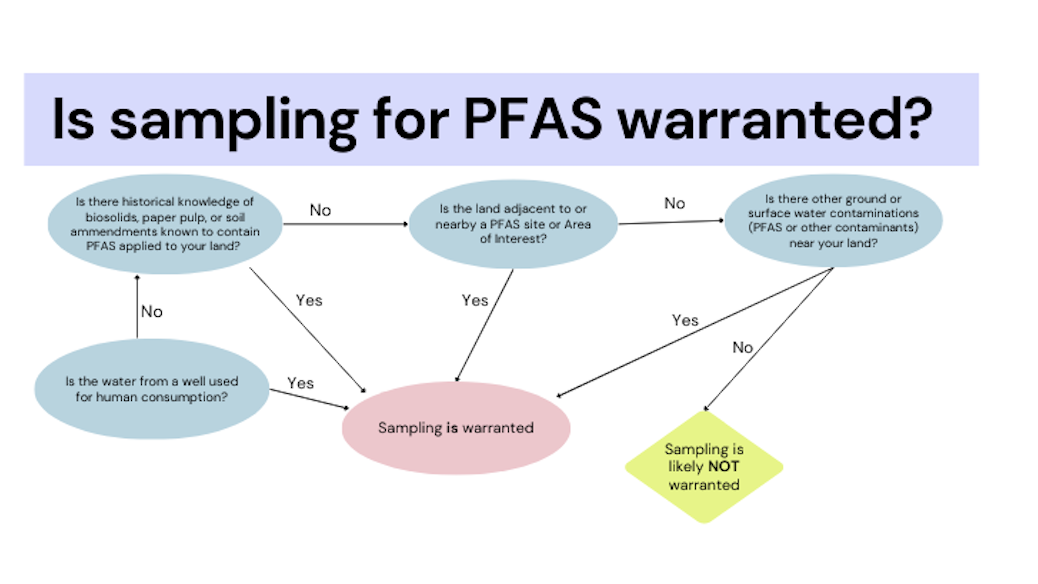What Does PFAS Mean To My Farm?
What does PFAS mean on my farm?
PFAS are a large group of manufactured chemicals that have been used in industry and consumer products since the 1940s. These chemicals break down slowly and can build up in people, wildlife, and the environment over time. There is evidence that exposure to certain PFAS chemicals, even at low levels, can negatively impact human health.
PFAS have inadvertently been brought on farms from contaminated biosolids spread on the land for fertilizer or from irrigation water from a contaminated water source. Farmers did not knowingly contaminate the soil or water. Once PFAS are in the water and soil of a farm, the chemicals can be taken up by crops and livestock. USDA and FDA have not yet set standards for PFAS for food and agricultural products but foods exported to other countries such as the European Union may be regulated in terms of allowable levels of PFAS. At the state level, there are no current guidelines for Michigan on PFAS contamination in soil, animal or plant tissue, however we expect this to change in the future.
Michigan State University Extension wants to help producers impacted by PFAS contamination continue to farm. We are prepared to have confidential conversations regarding risk, provide assistance with sampling, and help with strategies to manage contamination so that you can continue farming. Please contact Faith Cullens-Nobis at 517-388-1078 or cullensf@msu.edu for a confidental conversation.
Jump to Section:
Assessing Risk of PFAS Contamination on your Farm
Because PFAS chemicals are so common in the environment, it is believed that most soils across the country likely have a background level of PFAS deposited through air and precipitation. However, levels of contamination vary greatly based on the history of what has been applied to the soil. The highest levels tend to be associated with land that had sludge from industrial sources applied (paper, tannery, or sewage). PFAS have also been found in well water and surface water. If this water was used for irrigation, PFAS may have built up in the soil over time.
While the EPA recently stated that roughly 31 percent of the nation's sewage sludge is land applied as a soil conditioner or fertilizer to agricultural land, it is important to note that biosolids land application are only utilized on a relatively small portion of available agricultural land and that not all biosolids are contaminated with PFAS. An EPA report released in January 2025 estimates around 1% of US cropland receives biosolids applications.

To learn what Michigan is doing to keep PFAS contaminated biosolids off agricultural land, visit EGLE’s Michigan PFAS Biosolids informational page here.
There are steps you can take to determine the potential risk for PFAS contamination on your land.
Any well providing drinking water for human consumption should be tested for PFAS contamination. Funding is available to help producers offset the cost of testing. Please contact MSU Extension for further details.
First, determine if your land has had sewage sludge (wastewater treatment plant solids and/or septage) or soil amendments such as compost or manure known to contain PFAS. If there is no historical knowledge of the land, contact MSU Extension for additional assistance on gathering historical knowledge and data.
Second, determine if your land is adjacent to or in proximity to a known Area of Interest (AOI) or PFAS site. A PFAS site is defined as a property where EGLE has a valid groundwater monitoring well sample result that exceeds one or more of Michigan's seven PFAS groundwater cleanup criteria and EGLE has determined the property is the source of PFAS contamination (e.g., fire training area where PFAS-containing foam was used). An AOI is an area being investigated because of the potential for PFAS contamination affecting residential wells and the source has not been determined. PFAS sites and AOI's can be found using an interactive map on the MPART website.
Third, determine if there are other ground or surface water contamination that may be near or proximal to your farm by using the interactive map.
If any of these conditions exist, contact MSU Extension for further discussion on next steps on testing and financial assistance. If none of these conditions exist, PFAS sampling may not be warranted at this time.
Sampling
If you know that potentially contaminated material was applied to your land or that your property is adjacent or near a PFAS site, you may want have samples analyzed for PFAS. There is funding available to help with the costs, as testing is around $300-$500/sample.
It is possible to collect drinking water samples yourself using a home self-test kit provided by a certified drinking water lab, however, samples of soil, plant tissue, and other media are recommended to be collected by trained field technician familiar with PFAS sampling requirements. There is funding available to help with the costs of testing. Please contact MSU Extension for more information.
Drinking Water
Most laboratories will provide their own drinking water sample collection instructions and it is very important to follow the directions carefully. Because PFAS can be found on clothing, cosmetics, latex gloves, etc., there is a risk of cross contamination. PFAS compounds are detected in very small quantities (parts per trillion). Even the smallest cross-contamination could contribute to a false positive sample. Testing for PFAS is not cheap (~$300-$500/sample), therefore it is important that you take precaution when collecting a water sample. To ensure accurate results use the Private Residential Well PFAS Sampling Guidance and any additional instructions provided from the lab to collect your water sample. A list of laboratories certified to analyze for PFAS in drinking water and their fees can be found on the MPART website. The MSU PFAS Center Analytical Lab is also available for testing.
Ground Water and Surface Water
Ground water and surface water samples will need to be collected by an environmental professional. Funding is available to help offset the costs through MSU Extension. Please contact Faith Cullens-Nobis for further information. Since 2021, the state of Michigan has done routine monitoring of surface water from Michigan’s lakes and streams for PFAS analysis to identify potential sources of contamination. View more information at https://www.michigan.gov/pfasresponse/investigations/lakes-and-streams.
Soil, Plants, and Animals
Evaluating PFAS levels in soils, plants, and animals is much more complicated than for drinking water. If you are interested in testing other media such as soil, plant tissue, animals or animal products, please contact MSU PFAS Analytical Lab or work directly with a laboratory for further guidance. Funding is available to help offset the costs through MSU Extension. Please contact Faith Cullens-Nobis for further information.
Interpreting your Lab Results
Interpreting your lab results can be difficult. MSU has put together a printable guide on interpreting PFAS lab results to help.
Drinking Water Standards
Michigan drinking water rules were amended to include PFAS Maximum Contaminant Levels (MCLs), establishing sampling requirements for seven PFAS compounds in public water supplies covered under the Michigan Safe Drinking Water Act. It is likely that these standards will continue to be refined, so ensure that you check back for the most up to date information.
Private residential wells are not regulated under the Michigan Safe Drinking Water Act, but Michigan uses the MCLs along with other factors when evaluating private residential well results. If contaminated water is used for watering livestock or for irrigation, there is also a risk that the well water is contributing PFAS to milk, meat, eggs, soil and/or crops.
Surface Water and Ground Water, Soil, Plants, and Animals
Determining the level of concern for soils, crops and animals is more complicated than for water. USDA and FDA have not set standards for PFAS for food and agricultural products but foods exported to other countries such as the European Union may be regulated in terms of allowable levels of PFAS. At the state level, there are no current guidelines for Michigan on PFAS contamination in soil, animal or plant tissue. Michigan State University is continuing to research the factors affecting transfer of PFAS from soil to crops and animals. However, in other states, such as Maine, the state's Center for Disease Control and Prevention has set action levels for perfluorooctane sulfonate (PFOS) in beef (3.4 ppb) and milk (210 ppt), which guide decisions about whether to allow a farm’s beef or milk to be sold in the commercial market.
If PFAS concentrations are higher than expected in either water used for irrigation or soil, it can be expected that concentrations in crops could also be elevated. However, each farm scenario is unique and must be evaluated on a farm-by-farm basis. Specifically, the types of crops grown, the grazing patterns, the animal products produced, the end market of the crop will need to be considered for evaluation.
However, without current screening levels (or action levels) at the state or federal level, it is challenging to determine at what point elevated PFAS levels equate to a significant health and/or farm risk. The reason for this is that research is still ongoing in this area and we anticipate screening levels to be determined in the future. As awareness in PFAS contamination is increasing, we anticipate consumer driven purchasing decisions to impact agricultural production.
If you want to test the soil, crop or animal tissue (or have already) and have reason for concern, please contact Faith Cullens-Nobis at Michigan State University Extension to have a confidential discussion on risk assessment for your farm and financial assistance.
It is helpful to keep in mind the units of measure for PFAS concentrations.





 Print
Print Email
Email